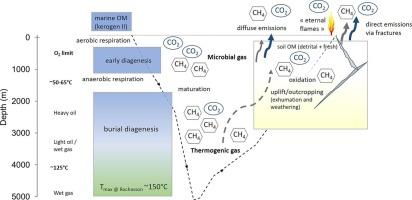地质温室气体排放和页岩风化:阿尔卑斯山“永恒之火”的教训
IF 8
1区 环境科学与生态学
Q1 ENVIRONMENTAL SCIENCES
引用次数: 0
摘要
据报道,在各种地质环境中都有天然碳氢化合物气体渗漏,它们对大气中强效温室气体(CO2, CH4)浓度的贡献可能相当大。沉积环境中的潜在气源包括富含有机质的烃源岩,如泥炭、煤层和页岩粘土。发生在法国亚高山链的天然甲烷渗漏的来源很少受到限制,只有很少的信息是关于富有机质页岩风化释放气体背后的机制,特别是当最近的构造作用叠加时。在被调查的地点,露头的卡洛纪-牛津纪黑色页岩通过宏观和微观渗漏排放甲烷、烷烃和二氧化碳,显示了这些机制的复杂性。本文报告了Meylan-Rochasson永恒火焰遗址的地球化学、同位素和岩石学数据,包括原位测量、气体、孔隙水和沉积物采样以及脱气实验,并提出了一个涵盖从早期成岩作用到发掘和风化作用的储层演化所有阶段的概念模型。在氦气作用下的岩石脱气实验可以提取孔隙水中溶解的烷烃和二氧化碳。20-40 cm以下的同位素特征与宏观渗漏相当,表明烷烃的共同热成因是有机质在~ 150°C的成熟。甲烷二次氧化过程影响着热源甲烷的点排放和漫射排放。在露头页岩和崩积层的孔隙水中,热成因气与微生物甲烷组分混合。在未来研究全球页岩直接天然气排放的重要性时,需要考虑风化、有机质氧化和微生物驱动过程的叠加作用。本文章由计算机程序翻译,如有差异,请以英文原文为准。

Geogenic greenhouse gas emissions and shale weathering: lessons learned from an alpine “eternal flame”
Natural hydrocarbon gas seeps have been reported over a wide range of geological settings, and their contribution to atmospheric concentrations of potent greenhouse gases (CO2, CH4) may be considerable. Potential gas sources in sedimentary environments include organic-rich source rocks such as peats, coalbeds, and shale clays. The origins of natural methane seepages occurring in the French Subalpine Chains are poorly constrained and only little information is available on the mechanisms behind the gas release by weathering of organic-rich shales, notably when overprinted by recent tectonism. The investigated site, where outcropping Callovian-Oxfordian black shales emit methane, higher alkanes and CO2 through macro- and micro-seeps, shows the complexity of these mechanisms. We report geochemical, isotopic and petrographic data from the Meylan-Rochasson eternal flame site, from in-situ measurements, gas, pore water and sediment sampling and degassing experiments, and propose a conceptual model covering all stages of reservoir evolution from early diagenesis to exhumation and weathering. Rock degassing experiments under helium allowed extracting alkanes and CO2 dissolved in pore waters. Isotopic signatures from below 20–40 cm are comparable to the macro-seep, indicating a common thermogenic origin of alkanes through maturation of organic matter at ∼150 °C. Secondary methane oxidation processes affect both point- and diffuse emissions of thermogenic methane. In the pore waters of outcropping shales and colluvium thermogenic gas mix with a microbial methane component. This superposition of weathering, oxidation of OM and microbially driven processes needs to be considered in future studies investigating the importance of direct natural gas emission from shales worldwide.
求助全文
通过发布文献求助,成功后即可免费获取论文全文。
去求助
来源期刊

Science of the Total Environment
环境科学-环境科学
CiteScore
17.60
自引率
10.20%
发文量
8726
审稿时长
2.4 months
期刊介绍:
The Science of the Total Environment is an international journal dedicated to scientific research on the environment and its interaction with humanity. It covers a wide range of disciplines and seeks to publish innovative, hypothesis-driven, and impactful research that explores the entire environment, including the atmosphere, lithosphere, hydrosphere, biosphere, and anthroposphere.
The journal's updated Aims & Scope emphasizes the importance of interdisciplinary environmental research with broad impact. Priority is given to studies that advance fundamental understanding and explore the interconnectedness of multiple environmental spheres. Field studies are preferred, while laboratory experiments must demonstrate significant methodological advancements or mechanistic insights with direct relevance to the environment.
 求助内容:
求助内容: 应助结果提醒方式:
应助结果提醒方式:


